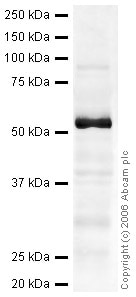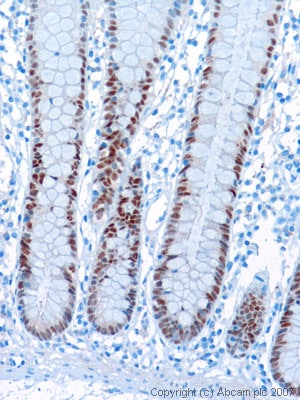Anti-KLF5 antibody (ab24331)
Key features and details
- Rabbit polyclonal to KLF5
- Suitable for: IHC-P, WB
- Reacts with: Human
- Isotype: IgG
Overview
-
Product name
Anti-KLF5 antibody
See all KLF5 primary antibodies -
Description
Rabbit polyclonal to KLF5 -
Host species
Rabbit -
Specificity
Some of our customers have successfully used ab24331 on mouse, please see PubMed ID: 19720868 and 21600198. However, we have been unable to show cross-reactivity with this species and therefore we cannot guarantee this product will consistently work on mouse. Please contact our Scientific Support team for further information. -
Tested applications
Suitable for: IHC-P, WBmore details -
Species reactivity
Reacts with: Human
Predicted to work with: Rat
-
Immunogen
Synthetic peptide corresponding to Human KLF5 aa 1-100 conjugated to keyhole limpet haemocyanin.
(Peptide available asab30882)
Properties
-
Form
Liquid -
Storage instructions
Shipped at 4°C. Store at +4°C short term (1-2 weeks). Upon delivery aliquot. Store at -20°C or -80°C. Avoid freeze / thaw cycle. -
Storage buffer
pH: 7.40
Preservative: 0.02% Sodium azide
Constituent: PBS
Batches of this product that have a concentration Concentration information loading...
Concentration information loading...Purity
Immunogen affinity purifiedClonality
PolyclonalIsotype
IgGResearch areas
Associated products
-
Compatible Secondaries
-
Isotype control
-
Recombinant Protein
Applications
Our Abpromise guarantee covers the use of ab24331 in the following tested applications.
The application notes include recommended starting dilutions; optimal dilutions/concentrations should be determined by the end user.
Application Abreviews Notes IHC-P Use a concentration of 0.6 - 3 µg/ml. WB Use a concentration of 2 µg/ml. Detects a band of approximately 52 kDa (predicted molecular weight: 50 kDa). Target
-
Function
Transcription factor that binds to GC box promoter elements. Activates the transcription of these genes. -
Tissue specificity
Expressed only in testis and placenta. -
Sequence similarities
Belongs to the krueppel C2H2-type zinc-finger protein family.
Contains 3 C2H2-type zinc fingers. -
Post-translational
modificationsUbiquitinated. Polyubiquitination involves WWP1 and leads to proteasomal degradation of this protein. -
Cellular localization
Nucleus. - Information by UniProt
-
Database links
- Entrez Gene: 688 Human
- Entrez Gene: 84410 Rat
- Omim: 602903 Human
- SwissProt: Q13887 Human
- Unigene: 508234 Human
- Unigene: 8954 Rat
-
Form
KLF5 (also known as basic transcription element-binding protein 2, BTEB2, and intestine enriched krüppel-like factor, IKLF), appears to play a central role in the regulation of intestinal epithelial renewal in both the small intestine and colon. KLF5 also regulates adipocyte differentiation. -
Alternative names
- Basic transcription element binding protein 2 antibody
- Basic transcription element-binding protein 2 antibody
- BTE binding protein 2 antibody
see all
Images
-
Anti-KLF5 antibody (ab24331) at 2 µg/ml + Small Intestine (Human) Tissue Lysate at 20 µg
Secondary
IRDye 680 Conjugated Goat Anti-Rabbit IgG (H+L) at 1/15000 dilution
Performed under reducing conditions.
Predicted band size: 50 kDa
Observed band size: 52 kDa why is the actual band size different from the predicted? -
The image shows nuclear staining of the epithelial cells of the intestinal gland. Tris EDTA pH9 and Citrate pH6 are both suitable antigen retrieval techniques.
-
All lanes : Anti-KLF5 antibody (ab24331) at 1/500 dilution
Lane 1 : Marker ladder
Lane 2 : Cell lysate prepared from human Ls174T cells at 40 µg
Lane 3 : Cell lysate prepared from IEC-6 rat intestinal cells at 40 µg
Secondary
Lanes 2-3 : HRP conjugated goat polyclonal to rabbit IgG at 1/1500 dilution
Predicted band size: 50 kDa
Exposure time: 2 minutes
Protocols
References (29)
ab24331 has been referenced in 29 publications.
- Dang X et al. miR-145-5p is associated with smoke-related chronic obstructive pulmonary disease via targeting KLF5. Chem Biol Interact 300:82-90 (2019). PubMed: 30639269
- Zhang Z & Zhu X Clinical Significance of Lysophosphatidic Acid Receptor-2 (LPA2) and Krüppel-Like Factor 5 (KLF5) Protein Expression Detected by Tissue Microarray in Gastric Adenocarcinoma. Med Sci Monit 25:4705-4715 (2019). PubMed: 31235682
- Hasegawa T et al. Characterization and Evidence of the miR-888 Cluster as a Novel Cancer Network in Prostate. Mol Cancer Res 16:669-681 (2018). PubMed: 29330297
- Liang H et al. miR-145-5p reduces proliferation and migration of hepatocellular carcinoma by targeting KLF5. Mol Med Rep 17:8332-8338 (2018). PubMed: 29658584
- Zhang C et al. KLF5 controls glutathione metabolism to suppress p190-BCR-ABL+ B-cell lymphoblastic leukemia. Oncotarget 9:29665-29679 (2018). PubMed: 30038712
Images
-
Anti-KLF5 antibody (ab24331) at 2 µg/ml + Small Intestine (Human) Tissue Lysate at 20 µg
Secondary
IRDye 680 Conjugated Goat Anti-Rabbit IgG (H+L) at 1/15000 dilution
Performed under reducing conditions.
Predicted band size: 50 kDa
Observed band size: 52 kDa why is the actual band size different from the predicted?
-
The image shows nuclear staining of the epithelial cells of the intestinal gland. Tris EDTA pH9 and Citrate pH6 are both suitable antigen retrieval techniques.
-
All lanes : Anti-KLF5 antibody (ab24331) at 1/500 dilution
Lane 1 : Marker ladder
Lane 2 : Cell lysate prepared from human Ls174T cells at 40 µg
Lane 3 : Cell lysate prepared from IEC-6 rat intestinal cells at 40 µg
Secondary
Lanes 2-3 : HRP conjugated goat polyclonal to rabbit IgG at 1/1500 dilution
Predicted band size: 50 kDa
Exposure time: 2 minutes













